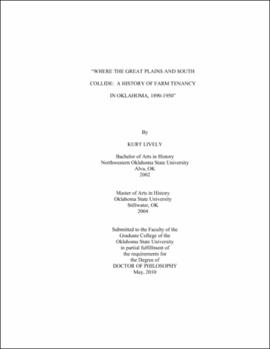| dc.contributor.advisor | Moses, L. G. | |
| dc.contributor.author | Lively, Kurt | |
| dc.date.accessioned | 2013-11-26T08:24:17Z | |
| dc.date.available | 2013-11-26T08:24:17Z | |
| dc.date.issued | 2010-05 | |
| dc.identifier.uri | https://hdl.handle.net/11244/6782 | |
| dc.description.abstract | Scope and Method of Study: This study examines the rise and fall of farm tenancy in Oklahoma. Primary materials include manuscript collections, agricultural newspapers, government documents, and census data. Secondary sources incorporated a variety of historical monographs and journal articles on farm tenancy, agriculture, and Oklahoma. | |
| dc.description.abstract | Findings and Conclusions: This study demonstrates that farm tenancy in Oklahoma was unique when compared with that in other states. Oklahoma farm tenancy was a hybrid of regional renting systems. Because Oklahoma sat at the intersection of two agricultural and cultural regions, farm tenancy in the state combined share tenancy from the Great Plains and cotton production from the South. Tenancy patterns in western Oklahoma mirrored rental conditions from the Great Plains; in eastern Oklahoma, tenants grew cotton, but they were predominantly share tenants, not sharecroppers. In addition, this study traces the development of farm tenancy from 1890 to 1950. Tenancy in Oklahoma had its origins in Indian land allotment in the 1890s. It grew into a cash-crop system by the 1920s. However, unlike tenants in southern cotton producing states, tenant farmers in Oklahoma remained a cohesive voting bloc and forced politicians to recognize and support their rights. Tenants in Oklahoma were not politically marginalized like southern sharecroppers and exerted more influence than renters from plains states. Despite moderate legislative success in 1920s, daily life improved very little and tenancy remained an institution of the rural poor. It was not until the 1930s that the federal and state government worked to eradicate tenancy through federal, state, and local programs. Despite these efforts, it was actually social and economic factors that ended the tenant era. A low standard of living, farm foreclosures, and farm consolidations forced many tenants from their farms in the 1930s. Finally, New Deal programs, wartime industry, and increased mechanization enticed remaining tenants to seek jobs with better pay, thus ending the era of farm tenants in Oklahoma by 1950. | |
| dc.format | application/pdf | |
| dc.language | en_US | |
| dc.rights | Copyright is held by the author who has granted the Oklahoma State University Library the non-exclusive right to share this material in its institutional repository. Contact Digital Library Services at lib-dls@okstate.edu or 405-744-9161 for the permission policy on the use, reproduction or distribution of this material. | |
| dc.title | Where the great plains and south collide: A history of farm tenancy in Oklahoma, 1890-1950 | |
| dc.contributor.committeeMember | Rohrs, Richard C. | |
| dc.contributor.committeeMember | Williams, Elizabeth A. | |
| dc.contributor.committeeMember | Bays, Brad Alan | |
| osu.filename | Lively_okstate_0664D_10865 | |
| osu.accesstype | Open Access | |
| dc.type.genre | Dissertation | |
| dc.type.material | Text | |
| dc.subject.keywords | farm tenancy | |
| dc.subject.keywords | oklahoma | |
| dc.subject.keywords | share tenancy | |
| dc.subject.keywords | sharecropping | |
| dc.subject.keywords | tenancy | |
| dc.subject.keywords | tenant | |
| thesis.degree.discipline | History | |
| thesis.degree.grantor | Oklahoma State University | |
